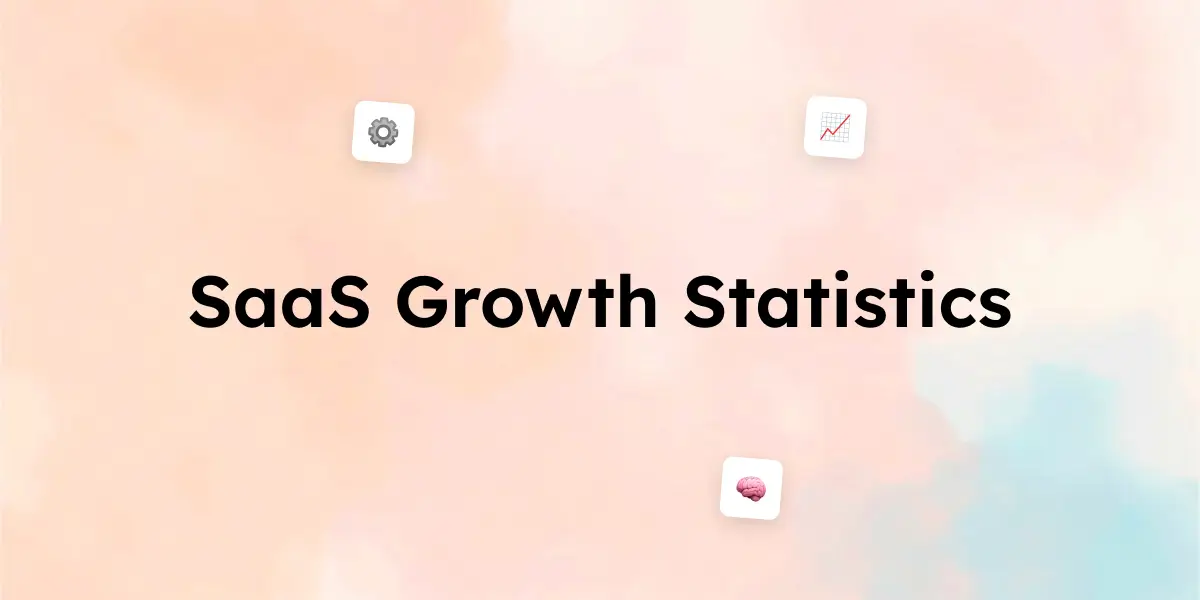The Software-as-a-Service (SaaS) industry continues to experience explosive growth, reshaping how businesses operate in 2025. With AI-driven automation, evolving pricing models, and an increasing shift toward cloud-native and mobile-first solutions, SaaS companies must stay ahead of emerging trends to maintain their competitive edge.
This report compiles 50+ essential SaaS growth statistics covering market expansion, customer acquisition, retention, churn, pricing models, and future trends to help SaaS businesses optimize their strategies.
Whether you’re a startup founder, a SaaS marketer, or an investor, these data-driven insights will help you navigate the ever-changing SaaS landscape in 2025.
SaaS Growth Statistics for 2025
1. SaaS Market Growth
- The global SaaS market is projected to reach $374.5 billion in 2025, up from $273.5 billion in 2023.
- The industry is expected to grow at a CAGR of 12.5% from 2023 to 2028.
- 99% of businesses will use at least one SaaS solution by 2025.
2. Revenue Trends
- SaaS companies generating $10M+ ARR grow at an average rate of 50-60% YoY.
- 70% of SaaS revenue comes from existing customers through upsells and expansions.
- The median gross margin for SaaS businesses is 78%, but top performers exceed 85%
3. Customer Retention & Churn
- The average SaaS churn rate is 3-8% annually, but high-growth companies aim for <5%.
- Increasing customer retention by 5% can boost profits by 25-95%.
- 80% of SaaS companies prioritize reducing churn over acquiring new customers.
4. Customer Acquisition & Sales
- The average Customer Acquisition Cost (CAC) for SaaS is $205-$600 per user.
- 57% of SaaS buyers prefer free trials or freemium models before purchasing.
- The average LTV to CAC ratio for successful SaaS businesses is 3:1.
5. Pricing & Subscription Models
- 85% of SaaS businesses offer a subscription-based pricing model.
- The average monthly SaaS subscription price is $58 per user.
- Usage-based pricing models are growing at 20% YoY as businesses seek flexibility .
- 57% of SaaS buyers prefer free trials or freemium models before purchasing.
6. SaaS Adoption & Trends
- 75% of businesses will rely on AI-powered SaaS tools for automation by 2025.
- Vertical SaaS (industry-specific solutions) is expected to grow 2x faster than horizontal SaaS.
- Security remains a top concern, with 73% of SaaS companies investing more in compliance.
7. Global SaaS Market Expansion
- The global SaaS market is projected to reach $247 billion by 2024, up from $197 billion in 2023.
- The SaaS sector is expanding at an annual rate of 11.96%, with over 16,000 startups contributing to this growth.
- The United States remains the largest SaaS market, growing from $108.4 billion in 2020 to a projected $225 billion by 2025.
8. Revenue and Growth Rates
- Over the past decade, the SaaS market has seen a compound annual growth rate (CAGR) of 25%.
- The SaaS industry is expected to reach $716 billion by 2030, with a CAGR of 18.3% between 2023 and 2030.
9. Adoption and Usage
- By the end of 2024, 99% of organizations will use at least one SaaS application.
- Organizations use an average of 112 SaaS tools, reflecting a 14% decrease from 2023.
- By 2025, 85% of business applications are expected to be SaaS-based.
10. Market Segmentation and Trends
- The Vertical SaaS market is estimated to reach $157.4 billion by 2025, expanding at a CAGR of 23.9%.
- The Asia-Pacific SaaS market is anticipated to grow at a CAGR of 16.1%, driven primarily by rapid growth in China and India.
11. Investment and Startups
- The SaaS sector receives an average funding of $11.5 million per funding round, with over 31,400 investors contributing to this amount.
- In 2024, Wayra, Telefónica’s venture capital division, invested €9.3 million in 37 startups, focusing on digitalization in sectors like banking, insurance, and health, with an emphasis on AI and SaaS systems.
12. Future Projections
- The global cloud market is expected to grow to $832.1 billion by 2025, with SaaS being a significant contributor.
- By 2025, an estimated 80% of B2B SaaS sales will take place online.
- Project management tools are predicted to be used by 50% of organizations by 2026 to centralize the management of SaaS applications.
13. Other Statistics
- Market Valuation : The global SaaS market is projected to reach $208 billion by 2025.
- Compound Annual Growth Rate (CAGR) : Between 2023 and 2030, the SaaS industry is expected to grow at a CAGR of 18.3%, aiming for a market size of $716 billion by 2030.
- Employment in SaaS : The SaaS sector employs approximately 2.2 million people worldwide, with an addition of 28,000 new professionals in the past year.
- Number of SaaS Companies : Globally, there are over 58,000 SaaS companies, with more than 16,000 identified as startups.
- Funding Rounds : The SaaS sector has completed over 6,500 funding rounds, supporting more than 15,000 companies.
- Investor Participation : More than 31,400 investors have contributed to the SaaS industry’s growth, with an average funding of $11.5 million per round.
- Patent Activity : The SaaS domain holds over 1,600 patents, with an annual growth rate of 18.48% in patent filings.
- Grant Support : The sector has received over 4,400 grants, accelerating research and development efforts.
- News Coverage : In the past year, more than 6,500 news stories have been published about activities in the SaaS sector, indicating heightened media attention.
- Search Interest : The SaaS sector has experienced a 14.21% annual growth in global search interest, reflecting increasing public and professional curiosity.
- AI Integration : By 2025, 75% of businesses are expected to utilize AI-powered SaaS tools to enhance automation and efficiency.
- Automation in SaaS Management : It’s predicted that by 2028, approximately 64% of SaaS management tasks will be automated, leading to more streamlined operations.
- Global Adoption Rates : By the end of 2024, 99% of organizations are expected to use at least one SaaS application, underscoring the near-universal adoption of cloud-based software solutions.
- Average Number of SaaS Applications per Organization : Organizations are utilizing an average of 112 SaaS applications, reflecting the deep integration of SaaS into daily business operations.
- Large Enterprise SaaS Usage : Enterprises with over 10,000 employees deploy an average of 447 SaaS applications, highlighting the scalability and extensive adoption in large organizations.
- Market Share by Country : The United States maintains a significant lead in the SaaS market, with revenues projected to reach $225 billion by 2025, up from $108.4 billion in 2020.
- SaaS Startups in the U.S. : The U.S. hosts approximately 9,100 SaaS companies, which is 8 times more than any other country, emphasizing its dominance in the sector.
- Cloud Workloads : It’s anticipated that by 2025, 95% of workloads will run in the cloud, indicating a significant shift towards cloud-based infrastructure.
FAQs on SaaS Growth in 2025
1️⃣ What is the projected size of the SaaS market in 2025?
The global SaaS market is expected to reach $307.3 billion in 2025, growing at a CAGR of 11.2%.
2️⃣ What is the average SaaS churn rate?
For enterprise SaaS, annual churn is around 3-7%, while SMB-focused SaaS sees 20-30% churn. Reducing churn by 5% can increase profits by 25-95%.
3️⃣ What are the biggest SaaS growth drivers in 2025?
The top SaaS growth drivers include:
AI & automation for better customer experiences.
Usage-based & freemium pricing models to improve conversion.
Vertical SaaS (industry-specific solutions) growing 3x faster than generic SaaS.
Edge computing & cloud-native platforms for faster performance.
4️⃣ How important is Net Revenue Retention (NRR) for SaaS companies?
NRR is critical for long-term SaaS growth. High-growth SaaS companies maintain an NRR of 110-140%, meaning they make more money from existing customers than they lose from churn.
5️⃣ What’s the best way for SaaS businesses to reduce CAC (Customer Acquisition Cost)?
To lower CAC, successful SaaS businesses focus on:
SEO & inbound marketing (8x higher close rates than paid ads).
Referral programs (customers from referrals have 3x higher conversion rates).
Freemium & free trial strategies (but only 2-5% of free users convert to paid plans).
Sources :
MadX
EcommerceBonsai
Wearetenet
StartUsInsights
PatProGlobal
Statista



